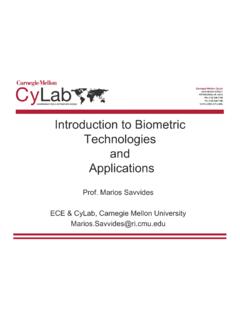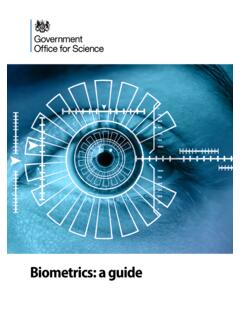Transcription of RFID Technology Principles, Advantages, Limitations & Its ...
1 International Journal of Computer and Electrical Engineering, , , February, 2011 1793-8163 151 Abstract This paper gives an overview of the current state of radio frequency identification (RFID) Technology . Aside from a brief introduction to the principles of the Technology , major current and envisaged fields of application, as well as advantages, and Limitations of use are discussed. Radio frequency identification (RFID) is a generic term that is used to describe a system that transmits the identity (in the form of a unique serial number) of an object or person wirelessly, using radio waves.
2 It's grouped under the broad category of automatic identification technologies . RFID is increasingly used with biometric technologies for security. In this paper Basic Principles of RFID Technology along with its types are discussed. Index Terms RFID Technology , RFID Principles, Components of RFID, Benefits , Limitations , applications . I. introduction In recent years, radio frequency identification Technology has moved from obscurity into mainstream applications that help speed the handling of manufactured goods and materials. RFID(Radio Frequency Identification) enables identification from a distance, and unlike earlier bar-code Technology , it does so without requiring a line of sight.
3 RFID tags support a larger set of unique IDs than bar codes and can incorporate additional data such as manufacturer, product type, and even measure environmental factors such as temperature. Furthermore, RFID systems can discern many different tags located in the same general area without human assistance. In contrast, consider a supermarket checkout counter, where you must orient each bar-coded item toward a reader before scanning it. So why has it taken over 50 years for this Technology to become mainstream? The primary reason is cost. For electronic identification technologies to compete with the rock-bottom pricing of printed symbols, they must either be equally low-cost or provide enough added value for an organization to recover the cost elsewhere.
4 RFID isn t as cheap as traditional labeling technologies , but it does offer added value and is now at a critical price point that could enable its large-scale adoption for managing consumer retail goods. Here, we introduce the principles of RFID, discuss its primary technologies and applications , and review the Manuscript received July 30, 2010. Mandeep Kaur and Manjeet Sandhu are associated with Sant Baba Bhag Singh Institute of Engg. And Tech., Padhiana, Jalandhar, Punjab, INDIA. Neeraj Mohan is working as Asstt. Prof. in Deptt. of CSE at Rayat & Bahra Institute of Engg. & Bio-Tech., Sahauran, Mohali, Punjab, INDIA. Dr. Parvinder S.
5 Sandhu is associated as Professor with Deptt. of CSE at Rayat & Bahra Institute of Engineering & Bio- Technology , Sahauran, Mohali, Punjab, INDIA. Email: challenges organizations will face in deploying this Technology . RFID is used to automatic data capture allowing contact less identification of objects using radio frequency. RFID compared to BAR CODES Similarly - a support tool to automate processes and to improve operations management. Reduces labor, eliminates human errors. Puts a wealth of data at your fingertips. Different, in that: Tags can be embedded and hidden with no need for line-of-sight. They can be read through wood, plastic, cardboard, any material except metal.
6 Tags can reprogrammed on-the-fly. Applicable in harsh environments, such as outdoors, around chemicals, moisture and high temperatures. II. RFID PRINCIPLES Many types of RFID exist, but at the highest level, we can divide RFID devices into two classes: active and passive. Active tags require a power source they re either connected to a powered infrastructure or use energy stored in an integrated battery. In the latter case, a tag s lifetime is limited by the stored energy, balanced against the number of read operations the device must undergo. One example of an active tag is the transponder attached to an aircraft that identifies its national origin [1].
7 Passive RFID is of interest because the tags don t require batteries or maintenance. The tags also have an indefinite operational life and are small enough to fit into a practical adhesive label. A passive tag consists of three parts: an antenna, a semi- conductor chip attached to the antenna, and some form of encapsulation. The tag reader is responsible for powering and communicating with a tag. The tag antenna captures energy and transfers the tag s ID (the tag s chip coordinates this process). The encapsulation maintains the tag s integrity and protects the antenna and chip from environmental conditions or reagents [8].
8 Two fundamentally different RFID design approaches exist for transferring power from the reader to the tag: magnetic induction and electromagnetic (EM) wave capture. These two designs take advantage of the EM properties associated with an RF antenna the near field and the far field. Both can transfer enough power to a remote tag to sustain its operation typically between 10 W and 1 mW, depending on the tag type. (For comparison, the nominal power an Intel XScale processor consumes is approximately RFID Technology Principles, Advantages, Limitations & Its applications Mandeep Kaur, Manjeet Sandhu, Neeraj Mohan and Parvinder S.)
9 Sandhu International Journal of Computer and Electrical Engineering, , , February, 2011 1793-8163 152 500 mW, and an Intel Pentium 4 consumes up to 50 W.) Through various modulation techniques, near- and far-field-based signals can also transmit and receive data [1]. A. Near-field RFID Faraday s principle of magnetic induction is the basis of near-field coupling between a reader and tag. A reader passes a large alternating current through a reading coil, resulting in an alternating magnetic field in its locality. If you place a tag that incorporates a smaller coil (Fig 1) in this field[23], an alternating voltage will appear across it.
10 If this voltage is rectified and coupled to a capacitor, a reservoir of charge accumulates, which you can then use to power the tag chip. Tags that use near-field coupling send data back to the reader using load modulation. Because any current drawn from the tag coil will give rise to its own small magnetic field which will oppose the reader s field the reader coil can detect this as a small increase in current flowing through it. This current is proportional to the load applied to the tag s coil (hence load modulation). This is the same principle used in power transformers found in most homes today although usually a transformer s primary and secondary coil are wound closely together to ensure efficient power transfer.






